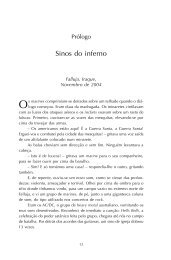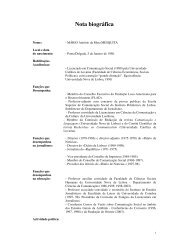A decade later - Fundação Luso-Americana
A decade later - Fundação Luso-Americana
A decade later - Fundação Luso-Americana
You also want an ePaper? Increase the reach of your titles
YUMPU automatically turns print PDFs into web optimized ePapers that Google loves.
een allowed to bring their own clothes.”<br />
And the thing most prisoners consider<br />
their only legal refuge – cigarettes – is<br />
totally banned both inside and outside the<br />
penitentiary grounds.<br />
The only rule that is not followed strictly<br />
by the book is the ban on physical contact.<br />
However, in the US, in this case, not going<br />
by the book means, “If it’s a short hug, we<br />
look the other way. But if it goes on too<br />
long, they get punished. Because there’s no<br />
touching allowed!”<br />
The same feeling of “off-limits” pervades<br />
visitation. The women can only hug their<br />
kids if they are seated. For two hours they<br />
remain in their chairs and are not allowed<br />
to get up and play with the children who<br />
are often enticed with candy so that they<br />
will stay on their mothers’ laps, prolonging<br />
the rare moment of physical bonding<br />
between mother and child.<br />
To keep the prison drug-free, the women<br />
have to strip when they first arrive and<br />
when they reenter the prison. Sometimes<br />
the examination involves a cavity search.<br />
The act, which is always accompanied by<br />
crying and complaining, has come about<br />
because of the bizarre stratagems the jailed<br />
drug-user will resort to. “The weirdest<br />
thing I’ve ever found, says Miller the guard<br />
who accompanied us on our visit, “was a<br />
crack pipe in somebody’s vagina.”<br />
In practical terms, the war on drugs, which<br />
has escalated since the Reagan administration,<br />
has had no effect on reducing crime<br />
and the brutal effects it has on women. It<br />
is a reality particularly felt within the prison<br />
system. In 2008, there were 2,821 inmates<br />
in New York State prisons and one in three<br />
had been jailed for drug-related crimes.<br />
We’ve already gone down several cell<br />
blocks when I notice that all the cells are<br />
alike. Unlike the women’s prison in Tires,<br />
there are no cut-out hearts or pictures<br />
adorning the partitions. That’s the way it<br />
is, they explain to me – tidy and impersonal<br />
– to prevent fires. The only things<br />
hanging from the cell walls are the surveillance<br />
cameras, which are there to keep<br />
track of the prison population, though they<br />
still do head-counts six times a day.<br />
By the next inmate tally, all the women<br />
have to be back in their quarters, so I have<br />
to use this chance to interview the women<br />
who have agreed to talk to me. They’ve<br />
given us an air-conditioned room which<br />
provokes smiles of relief when we walk in.<br />
The statistics show that 54% of all female<br />
prisoners in the US are black, but I’m sitting<br />
at a table with women who are not only<br />
white – but blond. The number of inmates<br />
has grown by 138% in the last 10 years<br />
because of the war on drugs and – in line<br />
socieTy<br />
children’s clothes on a prison clothesline show that children have also make this their home.<br />
‘ Alleging security reasons, even<br />
underwear from outside the jail<br />
has been banned. As Guard miller,<br />
50, recalls, “one inmate managed<br />
to sneak drugs in the waistband<br />
of her panties. From then on,<br />
they haven’t been allowed to bring<br />
their own clothes.”<br />
’<br />
with the statistics – most of the women<br />
seated around me are in for selling drugs.<br />
But let’s start with the exception. If you<br />
saw Petra on the street your last guess would<br />
be that she committed any crime. It would<br />
have been her last guess too. At 27, Petra<br />
has beautiful blond hair neatly rolled into a<br />
bun, and narrow Ben Franklin glasses adorning<br />
a pair of deep blue eyes. She has the air<br />
of a scholar.<br />
Nothing in her background fits the stereotypes<br />
or jibes with the statistics. The<br />
majority of prison inmates are black. She is<br />
blond and light-eyed. In the democratic<br />
West, prisons are the places that house the<br />
greatest number of illiterates per square foot.<br />
Fifty-eight percent of the female prison<br />
populations on this side of the Atlantic are<br />
high school drop-outs. Petra has a degree<br />
in Marketing. A large portion of the prison<br />
population complains of not having a regular<br />
Job: 74% of female American convicts<br />
were unemployed at the time of their conviction.<br />
Petra had a good job where she was<br />
earning 15 dollars an hour<br />
and had hopes of getting a<br />
promotion. She owned a<br />
house and a car and was, in<br />
short, financially several cuts<br />
above society’s customary<br />
outcasts.<br />
Though Petra’s case may<br />
seem less obvious, her emotional<br />
profile matches up<br />
perfectly with studies on<br />
criminality. A lot of research<br />
has shown that over 50% of<br />
all female prisoners were<br />
victims of physical or sexual abuse before<br />
being incarcerated. The figure is around<br />
15% for men. In other words, before victimizing<br />
someone else, Petra was herself a<br />
victim. Her boyfriend sexually abused her,<br />
took away her self-esteem and bludgeoned<br />
her with insults.<br />
As with the other women, she has a<br />
harder time talking about interrupted<br />
motherhood than she does about discussing<br />
her crimes. When you ask her about<br />
whom she left her 4 and 7 year-old children<br />
with she responds weeping, “When<br />
I was arrested my youngest was three. He<br />
was so upset, all his hair fell out.”<br />
Her other child is on the verge of being<br />
given into to the exclusive custody of the<br />
father. Once the legal battle begins, the<br />
system in the US is relentless. The father<br />
will have no trouble proving that he is a<br />
better guardian than the child’s delinquent<br />
mother. Petra has not seen the child for a<br />
year because the ex-boyfriend has boycotted<br />
every type of visitation.<br />
Parallel no. 6 | FALL | WINTER 2011 61<br />
JOSé CARLOS CARVALhO
















